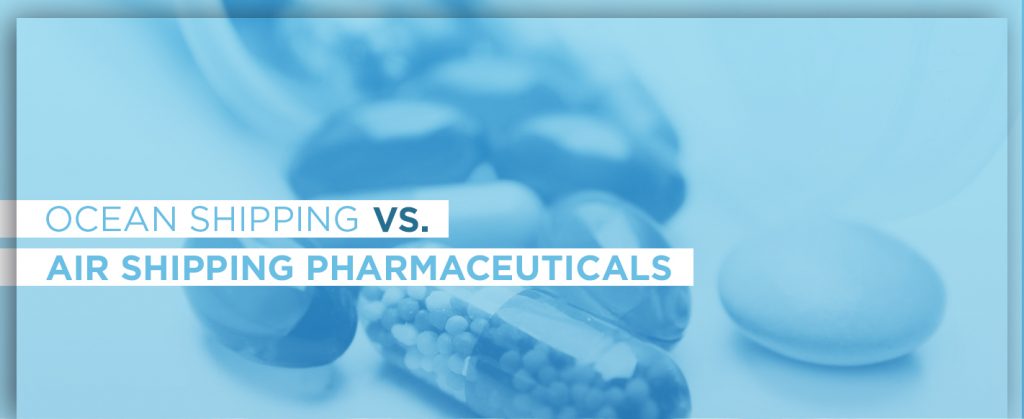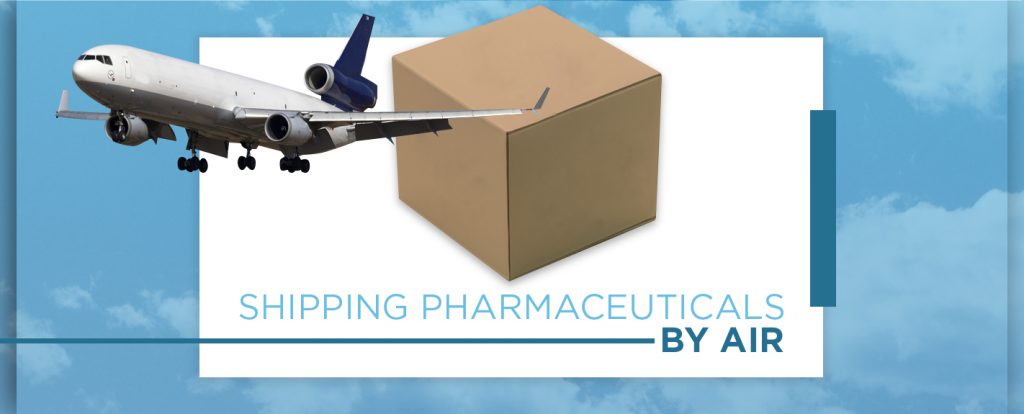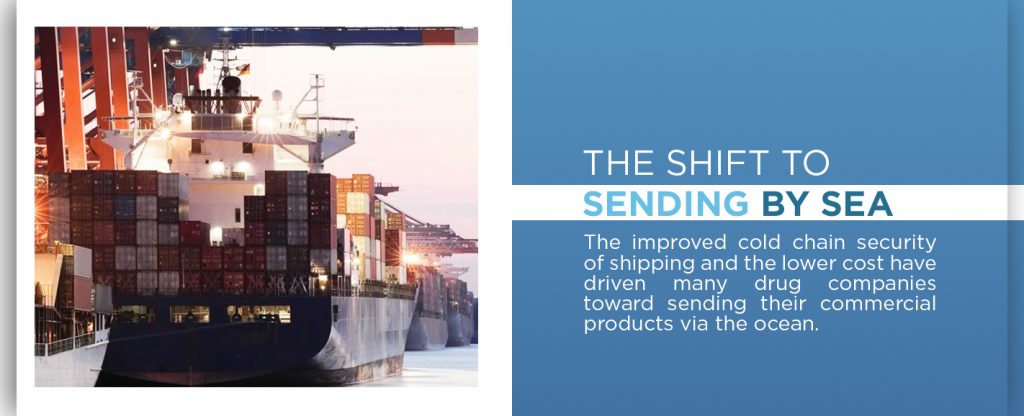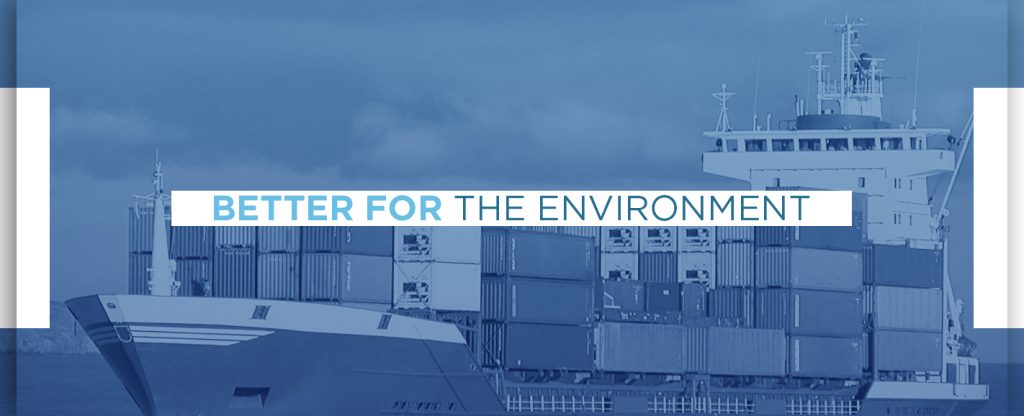
When shipping pharmaceuticals internationally, the decision of ocean shipping versus air shipping might seem obvious if the speed of air shipping is the only factor at play when sending sensitive medical supplies and drugs. Control, environmental concerns and cost now also play increasingly larger roles in choosing a conveyance method. Ocean transport may be a better option when you look at multiple facets of sending pharmaceuticals overseas.
Shipping Pharmaceuticals by Air

Air shipping sends the products faster, but the shipment speed may be the only advantage air has. Air freight costs more. But in instances when time trumps cost, such as with clinical trials or radioactive medications with short half-lives, the speed of air freight offsets the higher price. A delay in receiving a radioactive medication could mean the difference in whether the drug works as it should. If too many half-lives have passed, the remedy may be rendered inert. Loss of efficacy in some drugs could happen during the weeks required for ocean passages.
Smaller shipments sent by plane also lower the risk. Each sea-going container carries more cargo than an aircraft, which will result in a more devastating loss if the cargo encounters a problem. The increased risks have caused those using sea shipping to become extra cautious about maintaining the proper temperature, especially for environmentally sensitive drugs. This has also prompted development of temperature controlled containers and monitoring and tracking equipment of a much higher standard than was available a decade ago.
The Shift to Sending by Sea

The improved cold chain equipment and security of shipping and the lower cost have driven many drug companies toward sending their commercial products via the ocean. Drug makers AstraZeneca and Baxter have transitioned from mostly air transport of their products to ocean shipping.
In 2012, AstraZeneca sent only five percent of its goods by sea, but by 2017 the company shifted to sea shipping for more than 70 percent of its shipments. Baxter also strives to push intermodal transport for its products. This system replaces air shipping with more efficient ocean and land transport. Through this method, Baxter’s air shipments in 2017 dropped nine percent.
While these two major drug companies are at the forefront of logistics changes, they are not the only ones that are looking for a better option to more expensive air transport. There are several reasons sending medications by sea is better than air freight.
1. Control Over the Cold Chain
Controlling every step of the cold chain becomes critical with pharmaceuticals, especially vaccines and biologics. Depending on the drugs sent, the temperatures need rigid controls, within a few degrees of the ideal temperature. For the cold chain, the temperatures range from two to eight degrees Celsius with frozen pharmaceuticals requiring temperatures as low as -60 degrees Celsius. Controlled room temperature products are becoming more essential. With half of survey respondents said at least 50 percent of their products require temperature control, the industry has a real need to focus on how it ships its products.
For safe shipping, you must maintain strict control over the temperatures of the products. This control is critical when sending medications on a cargo boat. Boats hold more cargo in more tightly packed conditions than air freighters. You need automated control and backup solutions for maintaining the environmental conditions in the container that operate without a person aboard the ship intervening.
Ocean shipping containers are designed for long hauls. To ensure proper environmental regulation inside the containers, the refrigerated cold chain containers, also called reefers, increasingly have redundant systems. Backup systems include generators to maintain the required internal temperatures or insulation to protect the supplies inside. Satellite recording of the temperatures and alarms that signal temperature deviations help protect cold chain shipments over long sea voyages. Continuous monitoring of temperatures ensures safe transit the entire route.
Even by taking measures to control heat inside a container, the industry loses a significant percentage of its products through inappropriate temperature controls during shipping. Many vaccines may be rendered ineffective due to improper temperatures during transportation. Breaks in the cold chain contribute to damage occurring to 20 percent of temperature-sensitive products. Logistics also plays a role in the discarding of 30 percent of pharmaceuticals.
Controlling temperatures prevents deviations, which can ruin pricey shipments of medications. Ocean-going vessels only create one percent of all temperature excursions, compared to 80 percent for air transit. Part of the problem with air transport comes from unexpected delays. Often when transporting pharmaceuticals by air, the backup methods used are passive, such as pallet covers, blankets, or insulation. If a delay occurs beyond a few hours, the temperature inside the transit containers could rise too high. Delays may happen from customs problems, weather, transhipments or misloading cargo. Additionally, planes need more frequent stops for refueling, which increases the chances for interruptions.
The ability to control the cold chain is paramount for protecting the safety and efficacy of pharmaceuticals. Some products may become dangerous if their temperatures go outside their safe range. For instance, in 2017, Baxter International recalled its Intralipid 20 percent IV fat emulsion because the shipment froze. The freezing temperatures increased the size of the drops in the emulsion, which had the potential to cause blocked pulmonary circulation. Keeping medications and other medical supplies safe and at proper temperatures can save lives.
More control over the supply chain ensures the pharmaceuticals are more likely to reach their destinations intact. But transit is not the only place you need oversight in the cold chain. Up to 90 percent of problems in the chain occur from human error, and most of these errors happen during preparation and packing the air or ocean containers. Ocean shipments may help reduce these errors. Shipping reefers hold more than containers used for air transit. Fewer large containers to prepare, especially if all the containers have the same preparation, can lower the chances for human error while filling the reefers.
While controlling the cold chain is one advantage of ocean shipping, others exist that prove this transport method to be better for both the planet and for your bottom line.
2. Better for the Environment

With many companies seeking to reduce their carbon footprints, transport methods have come under scrutiny. Airplanes require large amounts of fuel and produce a lot of pollution compared to sea-going vessels. Ships have a carbon footprint one-twenty-fifth that of planes. With such a reduced impact on the environment, many larger corporations opt to send their larger shipments via sea or land transport or a combination of those.
Combining transit methods to make the most efficient, environmentally-friendly route is known as intermodal transport. This transportation method seeks to reduce emissions by finding alternatives to air shipping. Choosing water-going vessels to send medications and other supplies does have advantages when it comes to the environment. Companies that are making the transition are currently showing improvements in their carbon dioxide (CO2) emissions.
Baxter International is one pharmaceutical company attempting to decrease its air shipping and thereby cutting its carbon footprint. So far, the company has seen success. Though Hurricane Maria in 2017 affected Baxter’s push toward converting air transport to sea shipping, the company’s efforts the previous year decreased CO2 production in transportation by 25 percent.
Marine shipping contributes only four percent of the world’s CO2 emissions. But as ocean shipping becomes more popular, this percentage will likely increase. In fact, by 2050, emissions from shipping could rise by 150 to 200 percent. Carbon dioxide emissions, though, are only a part of the environmental picture. Other greenhouse gases exist, and marine shipping will likely increase its greenhouse gas production by up to 200 percent by 2050. While these numbers are concerning, sea-going vessels are still a much cleaner option than air transport for medications and new rules coming into effect in 2020 for exhaust emissions will additionally make this transport mode environmentally desirable.
The maritime industry acknowledges its greenhouse gas emissions. The International Maritime Organization (IMO) has tightened its policies for pollution in a three-fold program. In March 2018, the IMO required ships to gather data about their consumption of fuel. The industry, independent of growth, also needs to reduce its CO2 emissions to fulfill another requirement of the IMO’s plan. Lastly, the IMO requires reductions in sulfur oxide emissions by 2020. Today sulfur oxide accounts for 3.5 percent mass of sulfur per total mass, but by 2020, this percentage must decrease to 0.5 percent.
In addition to the tightened regulations, the shipping industry is looking to reduce its greenhouse gas emissions through the use of cleaner alternative fuels such as methanol and ethanol. These alcohols have the potential to cut both sulfur dioxide and carbon dioxide emissions while coming from a renewable source. Methanol has shown promise in the 2015 full main engine conversion of the ferry Stena Germanica. Ethanol has yet to be used successfully on ships, but it’s been integrated into diesel truck engines.
Despite these fuels’ benefits, they still have several challenges to overcome before they can be extensively used in the maritime industry. Regulations prevent these fuels from being used on ships due to their low flash points. Additionally, these fuels require more space to store aboard, which cuts down on the room available for cargo. Efforts to overcome these challenges will hopefully put these cleaner fuels into more ships in the future.
Current conditions make ocean-shipping a more environmentally friendly transport option, but with industry changes, it will become an even greener choice in the future. Changing to cleaner-burning fuels and adhering to tighter regulations will make marine shipping of pharmaceuticals better for medication producers and the planet.
3. Lower Pharmaceutical Transportation Costs
Of course, companies still have to stay in business, and costs come into play in almost every decision made. From a spending standpoint, marine shipping is a better choice than using airplanes. Ocean shipping costs 80 to 90 percent less compared to air shipping, and in addition to the lower transit costs, ocean-going pharmaceutical cold chain containers prevent product loss due to theft or temperature deviations, which further cuts costs.
Shipping via the ocean costs less than air transit in many ways. You will need fewer reefers because the containers used on boats are large so that you can ship more materials on fewer trips. Fewer trips and lower charges from the shipping companies make the outright cost to send products on cargo vessels much lower compared to air freight. Ocean transporters can do this because they comparatively use less fuel for the trip and carry more goods than planes.
Secondary costs are also lower when sending products over the ocean. Product loss from temperature deviations can dramatically cut into profits. The more massive reefers on boats often have active cooling mechanisms in addition to backup systems and temperature monitoring. Because the trips last weeks rather than hours, the reefers must have these redundant systems in place to protect the cargo during the voyage. With so many protections installed, you’re less likely to lose goods from poor storage.
One caveat to ocean shipping comes from the use of larger containers. If a single container’s cooling systems fail, more products will be lost. To prevent this loss, quality reefers use redundant, active cooling systems. For instance, in addition to an externally powered refrigeration unit, the containers also have a backup generator and an alarm to keep temperatures at the required level. Satellite temperature monitoring ensures the medications remain at their constant storage temperatures throughout the voyage, providing product quality and preventing loss.
Theft can be problematic, especially in the pharmaceutical industry. Luckily, marine cargo storage and reefers have ways to reduce property loss from thieves. Depending on the container brand, it may include an alarm that will sound if someone tries to open the reefer. The alarm will alert others aboard to the attempted theft while hopefully scaring off the criminal.
Storage methods aboard a ship also discourage theft. On a board, containers are tightly packed, making accessing them almost impossible. And opening a container to steal its contents is too tricky, especially when the container is wedged between others. Tight storage conditions on cargo vessels make it possible to protect both the integrity of the products inside the container and their safety.
For those interested in lowering their costs, switching to marine shipping will dramatically reduce the price compared to sending the products by air. The savings can offset the cost of purchasing the required reefers needed to send pharmaceuticals through the cold chain. But buying quality reefers will reduce hidden costs incurred from product losses.
Is Ocean Shipping the Future for Pharmaceuticals?

For the last several years, more companies have decided to embrace ocean shipping as a means of delivering their medicines. With more cold chain control, a lower carbon footprint and lower costs, ocean-going vessels have clear advantages over air freight. But because the shipments on boats are more substantial than on planes, temperature control is more important. Poorly controlled temperatures result in an average loss of four percent of drug companies’ shipments. Having quality reefers in which to send pharmaceuticals can help lower this percentage through several mechanisms.
Klinge Corporation is the major manufacturer of temperature-controlled containers to prevent product loss by offering redundant temperature control systems such as backup generators. Additionally, they adhere to regulatory agency requirements and additionally offer security and safety features installed on each container to protect the cargo inside. Whether you need minus 70-degree Celsius (-94 degree Fahrenheit) deep-freeze containers or just refrigeration units to add to your cold chain shipping, use the following link to contact Klinge Corporation to request a quote on solutions for medical transportation.
